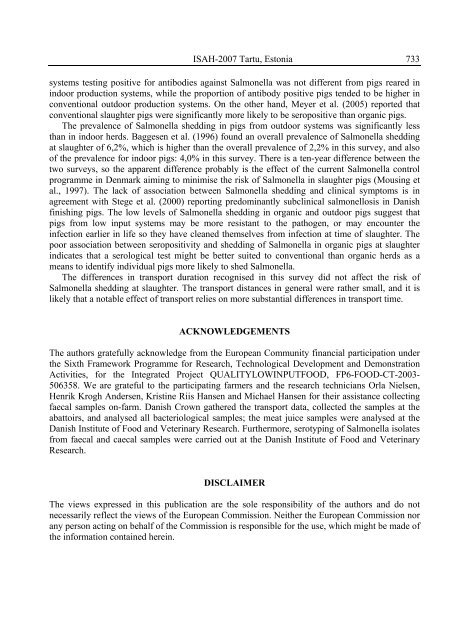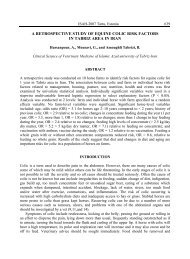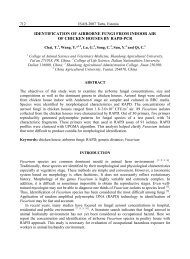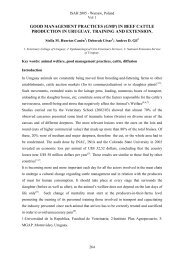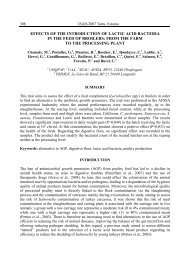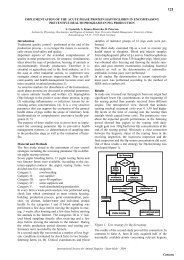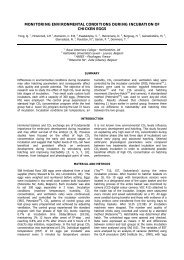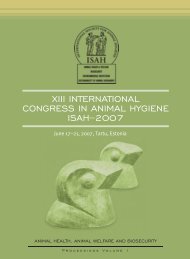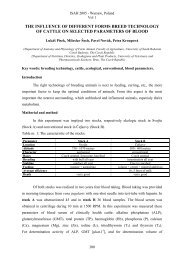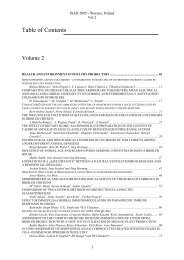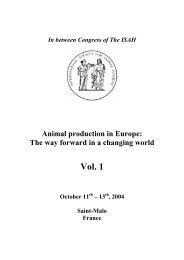salmonella infection level in danish indoor and outdoor ... - ISAH-SOC
salmonella infection level in danish indoor and outdoor ... - ISAH-SOC
salmonella infection level in danish indoor and outdoor ... - ISAH-SOC
Create successful ePaper yourself
Turn your PDF publications into a flip-book with our unique Google optimized e-Paper software.
<strong>ISAH</strong>-2007 Tartu, Estonia 733systems test<strong>in</strong>g positive for antibodies aga<strong>in</strong>st Salmonella was not different from pigs reared <strong>in</strong><strong>in</strong>door production systems, while the proportion of antibody positive pigs tended to be higher <strong>in</strong>conventional <strong>outdoor</strong> production systems. On the other h<strong>and</strong>, Meyer et al. (2005) reported thatconventional slaughter pigs were significantly more likely to be seropositive than organic pigs.The prevalence of Salmonella shedd<strong>in</strong>g <strong>in</strong> pigs from <strong>outdoor</strong> systems was significantly lessthan <strong>in</strong> <strong>in</strong>door herds. Baggesen et al. (1996) found an overall prevalence of Salmonella shedd<strong>in</strong>gat slaughter of 6,2%, which is higher than the overall prevalence of 2,2% <strong>in</strong> this survey, <strong>and</strong> alsoof the prevalence for <strong>in</strong>door pigs: 4,0% <strong>in</strong> this survey. There is a ten-year difference between thetwo surveys, so the apparent difference probably is the effect of the current Salmonella controlprogramme <strong>in</strong> Denmark aim<strong>in</strong>g to m<strong>in</strong>imise the risk of Salmonella <strong>in</strong> slaughter pigs (Mous<strong>in</strong>g etal., 1997). The lack of association between Salmonella shedd<strong>in</strong>g <strong>and</strong> cl<strong>in</strong>ical symptoms is <strong>in</strong>agreement with Stege et al. (2000) report<strong>in</strong>g predom<strong>in</strong>antly subcl<strong>in</strong>ical salmonellosis <strong>in</strong> Danishf<strong>in</strong>ish<strong>in</strong>g pigs. The low <strong>level</strong>s of Salmonella shedd<strong>in</strong>g <strong>in</strong> organic <strong>and</strong> <strong>outdoor</strong> pigs suggest thatpigs from low <strong>in</strong>put systems may be more resistant to the pathogen, or may encounter the<strong><strong>in</strong>fection</strong> earlier <strong>in</strong> life so they have cleaned themselves from <strong><strong>in</strong>fection</strong> at time of slaughter. Thepoor association between seropositivity <strong>and</strong> shedd<strong>in</strong>g of Salmonella <strong>in</strong> organic pigs at slaughter<strong>in</strong>dicates that a serological test might be better suited to conventional than organic herds as ameans to identify <strong>in</strong>dividual pigs more likely to shed Salmonella.The differences <strong>in</strong> transport duration recognised <strong>in</strong> this survey did not affect the risk ofSalmonella shedd<strong>in</strong>g at slaughter. The transport distances <strong>in</strong> general were rather small, <strong>and</strong> it islikely that a notable effect of transport relies on more substantial differences <strong>in</strong> transport time.ACKNOWLEDGEMENTSThe authors gratefully acknowledge from the European Community f<strong>in</strong>ancial participation underthe Sixth Framework Programme for Research, Technological Development <strong>and</strong> DemonstrationActivities, for the Integrated Project QUALITYLOWINPUTFOOD, FP6-FOOD-CT-2003-506358. We are grateful to the participat<strong>in</strong>g farmers <strong>and</strong> the research technicians Orla Nielsen,Henrik Krogh Andersen, Krist<strong>in</strong>e Riis Hansen <strong>and</strong> Michael Hansen for their assistance collect<strong>in</strong>gfaecal samples on-farm. Danish Crown gathered the transport data, collected the samples at theabattoirs, <strong>and</strong> analysed all bacteriological samples; the meat juice samples were analysed at theDanish Institute of Food <strong>and</strong> Veter<strong>in</strong>ary Research. Furthermore, serotyp<strong>in</strong>g of Salmonella isolatesfrom faecal <strong>and</strong> caecal samples were carried out at the Danish Institute of Food <strong>and</strong> Veter<strong>in</strong>aryResearch.DISCLAIMERThe views expressed <strong>in</strong> this publication are the sole responsibility of the authors <strong>and</strong> do notnecessarily reflect the views of the European Commission. Neither the European Commission norany person act<strong>in</strong>g on behalf of the Commission is responsible for the use, which might be made ofthe <strong>in</strong>formation conta<strong>in</strong>ed here<strong>in</strong>.


